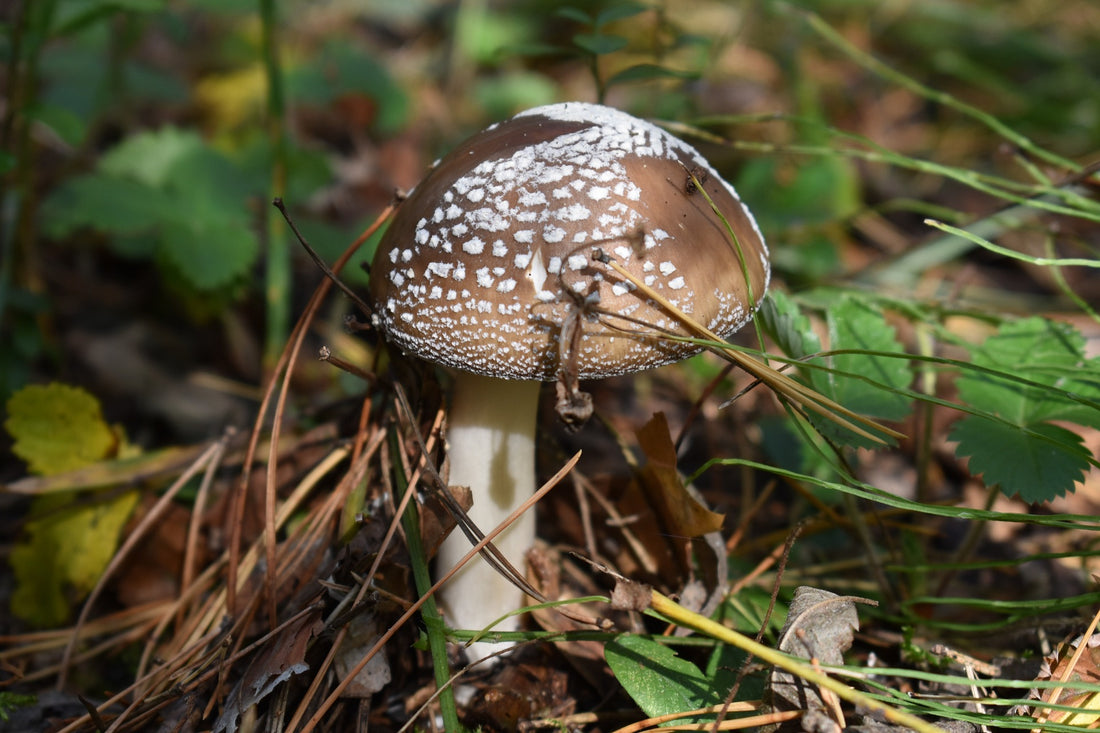Amanita Pantherina. Panther Cap. False Blusher. Whatever you call it, this mushroom is Amanita Muscaria's much stronger cousin. While it may not be as recognizable as the more-talked-about storybook mushroom, the Panther Cap typically contains a larger concentration of ibotenic acid and muscimol (the compounds that produce psychoactive effects).
But how did people learn about Amanita Pantherina's higher potency levels? Unlike Amanita Muscaria, the origins of this brown-capped white-spotted mushroom aren't well-reported. However, some history-loving researchers have compiled some evidence to help us understand exactly how they made their way into society.
Amanita Pantherina: The Potent Renamed Mushroom
The epithet "pantherina" and the common name "Panther Cap" both refer to the spotted appearance of the cap, which somewhat resembles the two-tone coat of the panther cat species.
However, upon its initial discovery, Amanita Pantherina was actually Agaricus Pantherinus.
Augustin Pyramis De Candolle, a Swiss-born mycologist who lived from 1778 to 1841, famously dubbed the species Agaricus Pantherinus in 1815. At the time, most of the gilled mushrooms were added to the genus Agaricus, including standard edible mushrooms.
However, Paul Kummer, a German mycologist who lived between 1834 and 1912, switched the mushroom's genus in 1871, renaming it Amanita Pantherina and commonly referring to it as Pantherpilz in his native language. And, as you'll already know, it holds this name today.
Amanita Pantherina In The History Books
We already mentioned that the Panther Cap's usage history isn't as well-documented as its less-potent cousin's. However, some suggest that Siberian, Pan-American, and European shamans may have used it in religious, spiritual, and recreational practices.
Other researchers have found implications of the mushroom's usage in ancient Greek mysteries, especially within The Mysteries of Dionysus. And some even discovered similar implications in the Mithraic Mysteries of Rome.
The Vikings purportedly utilized Amanita Muscaria before heading into battle, claiming the mushroom gave them superior strength. But some researchers have concluded that the notable warriors may have actually used Amanita Pantherina instead.
The Berserkers Used the Panther Cap to "Go Berserk?"
Perhaps the most famous Viking warriors were the Berserkers, which literally translated to "bear shirt" from Old Norse.
These shock troops earned their name by wearing hollowed-out bear pelts during battles. And historians have suggested they chewed dried mushrooms before fighting to dull pain and get the frenzy effect.
Viking art, like statues by Lewis Chessmen, dubbed the Berserkers "Shield Chewers." And archaeological evidence supports the idea that these warriors used mushrooms with no other drug use.
Some such evidence includes finding mushrooms within in their belongings that came from both non-Scandic and Scandic regions. While it may seem unlikely that they'd get ahold of items from outside their region, historians note that trading was rampant, making it a very possible occurrence.
Ulfhednar Purportedly Loved Amanita Pantherina
Anybody could become a Berserker, but you had to be someone ultra-special to be crowned an Ulfhedinn (the singular of Ulfhednar, plural).
With a name meaning "wolf hide," the Ulfhednar were a shamanistic class of worries. You can consider them the elite of the elite.
They were secretive, operating in small groups. You had to be invited into their fold, whereupon you'd learn an all-new level of fighting skills from older members.
Berserkers, on the other hand, came in hoards, openly living and serving the King, Jarl, or Chieftain.
Ulfhednar weren't just different in their operations, but they looked different, too — no hollowed-out bear pelts for them! Instead, these under-the-radar warriors went tunic-less into battle, opting to paint their bodies black instead. They didn't even use shields or armor!
And while there are numerous historical accounts of Berserkers flooding the battlefield, there is only one account of the Ulfhednar — they fought alongside Bersekrs in the Norway-unification battle of the ninth century.
Ulfhednar accounts liken them to the modern-day special forces. However, there is little known about them (due to their secretiveness).
Although, one thing is certain — the Ulfhednar participated in countless shamanistic forest rituals (i.e., eating herbals/drugs) during their lifetimes. And yes, Amanita Pantherina is thought to be their psychoactive consumable of choice.
Soviet Troops Feasting On The Super-Strength Panther Cap
The Berserkers and the Ulfhednar aren't the only battle-ready groups who reportedly used Amanita Pantherina, though.
In the book Shooting Up: A History of Drugs in Warfare by Kamieński, a report from Sroka mentions Soviet troops in 1945 utilized mushrooms before the Battle of Székesfehérvár in Hungary.
Amanita Pantherina in Present-Day Pop Culture
As you know, psychoactive mushrooms haven't disappeared from use. In fact, they're becoming increasingly popular, finding their way into mainstream discussions (Amanita Muscaria has been the tell-tale storybook symbol for centuries, after all).
But while most people consider the Flay Agaric the "go-to," more experienced consumers will opt for its super-strength cousin, the Panther Cap.
While evidence of Amanita Pantherina's effects is purely anecdotal, the modern-day user appreciates the purported alterations of space and time awareness that the potent mushroom brings when prepared correctly.
That said, the effects are similar to those gleaned from Amanita Muscaria, you just don't have to eat as much of the Panther Cap to feel them, thanks to its higher ratios of ibotenic acid and muscimol.
But Speaking of Potency, There's Something You Need to Keep in Mind
Regardless of the type of mushroom, strong potencies aren't guaranteed.
But why? Surely it's just a species-by-species difference?
Unfortunately not. Amanita Pantherina's potency depends on a myriad of factors, including:
- habitat
- season
- growing conditions;
- and age.
But even then, the percentages of ibotenic acid and muscimol vary from mushroom to mushroom. So, those grown in exactly the same area can contain different ratios.
That said, the Panther Cap is almost always stronger than its Fly Agaric family member.
There's More to Add to Amanita Pantherina's History in The Future
Provided research and use of fungi continue, there's bound to be more solid evidence added to the Panther Cap's history as time ticks forward — and we can't wait to see the developments.

